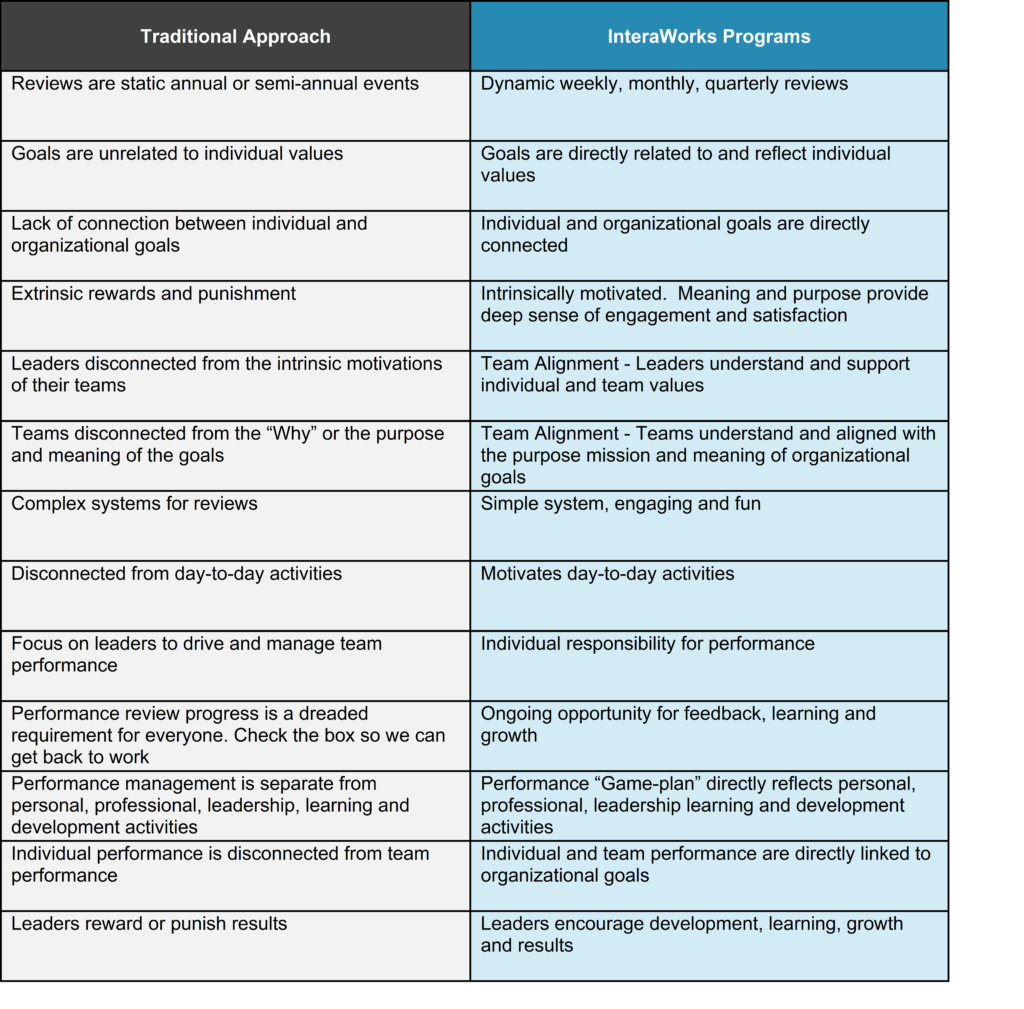In his popular book entitled “Drive. The Surprising Truth About What Motivates Us,” New York Times bestselling author Daniel Pink makes a compelling case that the human need to learn, grow, and “to do better by ourselves and our world” is a basic human drive and one that can be much stronger than external motivators such as rewards and punishments.
Human beings are innate learners. We love novelty and constantly seek out new and different experiences that enhance our lives, our relationships, and our communities. It is only through cultural conditioning over time that we tend to dampen this innate desire. Organizational cultures that reward only achievement and do not pay heed nor reward the process of learning and growth can stunt creative expression. However, given the right cultural conditions, the human drive to create, learn, and grow can be revitalized and developed.
We sat down with InteraWorks CEO, Laurie Oswald, and Director of Practice, Anne Mcghee-Stinson, to discuss how the team at InteraWorks drives their own growth and organizational alignment.
How do you tie your organization’s shared purpose and values back to your team to guide their decision-making?
[Laurie] We review our purpose and mission together every month with all team members. That keeps us connected to it and centered on how that shapes our choices and actions. We review our values quarterly and use them as our north stars when making decisions. We also incorporate purpose in our project and goal charters which creates alignment for why we are taking something on and ensures we are all on the same page. In addition, we start our hiring, partner, and client conversations in this space which creates alignment multi-directionally. When we come from the same place, the rest is much easier.
[Anne] Best Year Yet ® of course! Our team planning sessions “pull” the individual and shared purpose out from the team as opposed to the old model of doing business where the purpose was “assigned” or “driven” by leadership. Shared purpose means shared leadership and the BYY Process integrates values, shared purpose, and shared decision making into the day-to-day guidance system in the organization.
How do you align the energy of your team and the capabilities, systems, and processes of your organization so that everyone is moving in the same direction?
[Laurie] A few years back, we created a 5-year Vision altogether, not as a top-down effort. That vision provided us with an inspiring aspiration that we also review every month. Each year is different given the rapid changes in our world and in business. Setting the right mindset each year to grow and excel given the circumstances is critical. Stopping to reflect and celebrate what is working, share disappointments, learn from both and then creating a team plan is the cornerstone of our success. We use one of our own programs, Best Year Yet for Teams to do this annually. When you have a framework plan, north stars for guidance, and everyone contributing in a shared leadership model, you don’t need much more than that. Well, except fun which includes as many ways as possible!
[Anne] Shared purpose and values have to be woven into the processes, priorities, and practices of the organization ~ they have to be part of the fabric of the organization and they have to be living and breathing or else they are just words on a fancy ppt slide. It is a constant process of pulling from the team (what works, what doesn’t work, how do we do this even better, innovating, adjusting, and realigning).
How do you ensure that the right team members’ skills and strengths are utilized in the right role?
[Laurie] Our practice is to identify the strengths and desired responsibilities for each team member and create opportunities where both can flourish. We can’t always align the timing and business needs perfectly, but generally, if you create space for people to do what they are best at and what they love, the best results tend to follow. We also move responsibilities around so the team knows they will have chances to try something new or take on an area of interest without fear of failure.
[Anne] Ask, observe, adjust, ask, observe, adjust again. I believe that motivation is the natural state of most human beings. Creating engagement is a function of creating the right environment. When individuals are operating on intrinsic motivations, the entire organization becomes more holistically activated, and we begin to see a self-generative culture of performance. We just have to create the space for that motivation to be expressed. Joy, enthusiasm, creativity, and innovation occur naturally when someone is engaged in an activity that is meaningful to them. When people are happy, they do good work, they are fulfilled and there is a sense of satisfaction. To create a culture wherein these elements are common, we must leverage every interaction, be rigorously consistent, and shift mindsets into ones that look for and acknowledge areas of growth and learning.
How has the use of a collaborative planning process impacted the success of your annual and long-term organizational goals?
[Laurie] A collaborative approach builds relationships, diversifies ideas, spurs creativity, enhances trust, and fosters commitment at the level of teaming which is foundational for any organization to succeed and/or navigate tough times. No leader knows it all. And if they think they do, they are missing a big opportunity to harness the energy and smarts of their best resource– the people around them. Consider empowering your team to create your 2022 plans and see what happens!
[Anne] First and foremost it’s easier because everyone is moving in the same direction and there is already shared purpose, motivation, and leadership. Secondly, because we are constantly course-correcting and adjusting, it is RARE very, very rare that we don’t achieve our long-term organizational goals. Short-term goals get adjusted – but long-term meaningful objectives are the real game and we all have our eyes and hearts set on those.
Engagement is a function of creating intrinsically motivated goals.
When priorities do not tap into these inherent values, they become transient and temporary. Performance suffers and even if the results are achieved, the sense of satisfaction or accomplishment is temporary. Integrating performance with an individual’s values creates intrinsic motivations that are aligned and generates a sense of ownership and engagement that far exceeds what extrinsic rewards can provide.
As a result, individuals:
- Demonstrate and sustain a higher level of engagement
- Increase their long-term level of commitment
- Can replicate or exceed the results
- Develop a pattern of applied learning and growth
These attributes are created at the individual level before they are imbued at the organizational level. Below are some key distinctions between the more traditional approach to performance development and the InteraWorks approach.

When we are engaged through meeting our needs to create, connect and grow, we are able to operate at our fullest capacity. Taking the time to understand what drives humans will create an environment of compassion and ultimately, success.
Author – Stacy Cross
Learner Engagement Lead
About InteraWorks
InteraWorks is a global learning company on a mission to elevate the human experience at work. Specializing in professional development and performance enablement, we offer top-rated learning programs based on four defined conditions that must exist for individuals, teams including Effective Edge, Best Year Yet, and the Essentials series. Our integrated learning framework and online tools generate immediate and sustainable breakthroughs in performance. Through decades of working at all levels in enterprise companies across many industries, we’ve built a reputation for helping people and organizations harness their focus, mindset, talent, and energy to produce results that matter most.
We’ve defined four conditions that must exist for an individual, team, or organization to be effective within the arena of performance and development; Accountability, Focus, Alignment, and Integrity. We’ll continue to explore these and more in our blog and look forward to your engagement and interaction with us. Stay tuned as we engage the edges.

